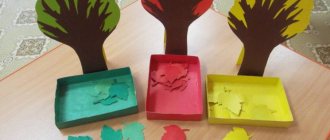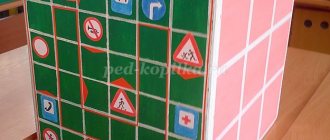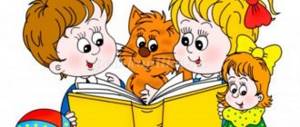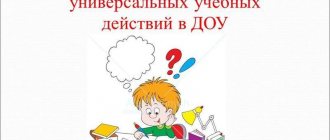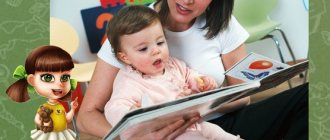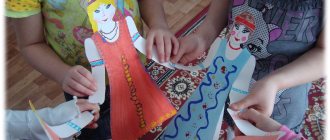Features of speech development of children with special needs development
- The group of children with OSD includes various speech disorders (the most popular are dysarthria and alalia). There are 4 forms of OHP:
- Level 1 – absence of common speech. Onomatopoeia and sound complexes are widely used.
- Level 2 - “rudiments” of speech. The baby can pronounce simple phrases and carry on a dialogue. The speech is unclear.
- Level 3 - various pronunciation defects (mainly complex sounds), errors in word formation and inflection.
- Level 4 - residual violations. The skills of analysis and synthesis are well developed; there are errors in the coordination and formation of unfamiliar words.
Teaching literacy to a child with speech impairments
A feature of visual memory in children with ODD is its reduced level. Improves with constant training in a playful way. Example of a game: place a number of objects in a row in front of the baby, ask him to look at them carefully and remember. The child closes his eyes and one object is removed. The preschooler must name which item is missing.
Play of children with level 4 OHP
Scientific and methodological principles of methods for teaching literacy to children with special needs development
To the question: “What method is used to teach literacy to preschoolers with speech disorders?” at the beginning of the article the answer was given - sound, analytical-synthetic. Therefore, in order for a child to master literacy, it is necessary to develop:
- analysis and synthesis;
- visual-figurative thinking;
- general and fine motor skills;
- attention and memory.
Make sentences based on an object picture
Exercises with object pictures can increase the volume of visual memory of children with speech impairments and stimulate the development of the child’s own monologue.
Additional Information! In the process of drawing up proposals based on subject pictures, the skills of analysis and synthesis are formed.
For example: a child names what is shown on the card in front of him, and then the speech therapist asks him to name the first sound in the word (just spoken by the baby).
Exercises to prevent violations of written speech in older preschoolers with ODD
The program for preventing writing disorders in older preschoolers prescribes the following exercises:
- on the development of phonemic hearing, analysis and synthesis: distinguishing speech and non-speech sounds, repeating after the teacher, the ability to select the required sound from the one named, composing words with a given sound.
- simultaneous familiarization with letters while learning sounds.
- development of motor skills.
- improving paper orientation abilities. A sheet of paper and a pencil are provided (if necessary, a children's simulator to properly hold the instrument in the hand). The tasks can be very different: draw a circle in the lower left corner of the sheet, a square in the upper right, etc.
Games on sound culture of speech in secondary and preparatory groups
Dysgraphia prevention
Dysgraphia is a disorder of writing processes that manifests itself in illogical, systematically repeated errors in words where it would seem impossible to make them.
Additional Information! There is a close relationship between oral and written children's speech.
In order to prevent the occurrence of dysgraphia, it is necessary to form:
- skills of distinguishing speech sounds (including similar sounds, for example whistling - hissing).
- correct pronunciation.
- a preschooler's wide passive and active vocabulary and his visual-spatial representations.
First acquaintance with phonetics and graphics of the language
The first acquaintance with phonetics and the formation of basic graphomotor skills in children with general speech underdevelopment occurs in several stages.
- A way of naming words with the required sound. “Tell me five words with the [c] sound.”
- Analysis of a word and development of skills in determining the place of sound in a word. “What is the first sound in the word lamp?”
- Initial acquaintance with the letter in the process of reading a work of fiction.
- The completed image is consolidated by numerous laying out letters from available materials (counting sticks, strings).
- A technique for writing letters multiple times in copybooks.
- Using sound-letter schemes, where you need to lay out already familiar letters and name the rest according to their meaning.
- The same methods are used to develop syllabic and full reading. At the moment, there are a huge number of step-by-step lessons - from sound to word - where in one manual the entire range of activities for teaching a child to read and write is collected.
Children's reading activities
Teaching literacy to children of senior preschool age with speech impairments
Bibliographic description:
Burachevskaya, O. V. Teaching literacy to children of senior preschool age with speech impairments / O. V. Burachevskaya. — Text: direct // Questions of preschool pedagogy. — 2020. — No. 2 (5). — P. 75-79. — URL: https://moluch.ru/th/1/archive/34/1048/ (date of access: 10.10.2020).
The article reveals the methodology for teaching literacy to children with speech impairments. The program content of the educational field “Teaching Literacy” is described. Techniques and methods for teaching sound, sound-letter and syllabic analyzes of words of various syllabic structures are revealed.
Key words: literacy training, language analysis, sound analysis of a word, sound-letter analysis of a word, syllabic analysis of a word, speech disorders
The key idea of teaching literacy to preschool children is the principle of child psychologist D. B. Elkonin: “The initial principle of the system of preschool literacy teaching is that a child’s acquaintance and work with letters should be preceded by a pre-letter, purely sound period of learning, a letter is a sign of sound.” [1]. The most effective age for using a child’s capabilities in mastering literacy is considered to be the senior preschool age. This period is called the period of “linguistic giftedness,” in which the child shows increased sensitivity to the sound side of speech, to the sounding word [4].
For preschool children, working with the intangible sound matter of a word is very difficult, so sound analysis, the pre-letter stage of learning to read and write, is of great importance and takes a lot of time and effort. The success of further development of reading skills depends on the pre-letter stage of learning.
Children with speech development disorders have pronunciation defects, a poor vocabulary, and construct very short phrases that are full of ungrammatical words. Therefore, when working with this category of children, a completely different approach is required, special correctional and developmental classes, where the skills of sound analysis of words play an important role. When phonemic representations are not formed, readiness for sound analysis of speech turns out to be much weaker than in preschool children with normal speech development. Therefore, when developing a methodology for correctional education, especially great importance is attached to compliance with fundamental didactic principles (availability of the proposed material, clarity, individual approach, etc.) [3]. In order to prepare children for learning to read and write using the analytical-synthetic sound method, it is very important to form in children the necessary readiness for the process of learning to read and write and to develop the basic prerequisites for the prevention of writing disorders (dyslexia and dysgraphia) that arise during schooling in children with impaired speech development.
The goal of literacy training is achieved by solving the following correctional and developmental tasks :
- form ideas about sensory standards (color, shape, size);
- develop visual perception and spatial orientation, the idea of the linearity of a series of symbols, signs (from left to right);
- develop auditory and phonemic perception;
‒ develop the ability to characterize sounds based on acoustic and articulatory characteristics;
- develop the ability to differentiate phonemes by ear and in one’s own pronunciation;
‒ form ideas about the word, its meaning (based on subject correlation), about the sentence;
‒ develop the ability to divide sentences into words, compose sentences of 2-3 words without prepositions and with prepositions (based on a visual diagram);
‒ develop the ability to conduct sound analysis of sound combinations and 3-5 sound words;
‒ develop the ability to isolate sounds from words and determine the place of sounds in a word;
- develop the ability to determine the sequence of sounds in a word;
- develop the ability to determine the number of sounds and syllables in a word;
- to develop the ability to carry out syllabic analysis of words of various syllabic structures (based on a polysensory approach: clap the number of syllables, blink, touch your ears, pat yourself on the stomach, shoulders, blow, jump, take as many steps as there are syllables in the word);
- to develop phonemic synthesis skills;
‒ form clear phonemic representations based on the ability to select words for a given sound;
- form ideas about vowels and consonants;
- to form the concept of the syllabic role of vowel sounds;
‒ form the concept of “stressed syllable”, the ability to identify a stressed syllable in a word;
‒ to form phonemic competence: the ability to establish the relationship between the sound and symbolic composition of words and the ability to recode the sound code into another sign system (phoneme - articulome - grapheme);
‒ develop integrative functions through coordination in the “eye-hand” system (visuo-motor integration), in the “ear-hand” system (auditory-motor integration), in the “ear-eye-hand” system (auditory-visual-motor integration );
- form ideas about letters, develop the ability to lay out letters from sticks, sculpt from plasticine, “draw in the air,” form letters from fingers;
‒ to develop the ability to distinguish and correctly use terms: sentences, words, syllables, sounds, letters.
Rice. 1 Symbolic designation of the characteristics of a consonant and vowel sound
The content of the material being studied is presented based on the leading activities of preschool children and is organized in the form of a game-activity while maintaining the structural components of the program plan. The use of this organizational form not only contributes to the solution of educational and correctional tasks, but is also an additional means of developing the child’s motivational-need sphere and contributes to the retention of cognitive activity and sustainable cognitive interest of children, more intensive emotional and personal development, the formation of arbitrariness of behavior and self-control as the most important basis to begin systematic schooling [2]. To facilitate the formation of the ability to carry out sound analysis of a word, symbolic designations of the characteristics of vowels and consonants are introduced (Fig. 1, Fig. 3), symbols “number of syllables” and “number of sounds” (Fig. 2).
To successfully learn to read, children need two discoveries: first to discover that speech is built from sounds, and then to discover the relationship between sounds and letters.
Rice. 2 Symbols “Number of syllables”, “Number of sounds”
Preschool children with speech development disorders are able to master the sound analysis of words using a certain method of acting with a word - intonation underlining, sequential prolongation of sounds in a spoken word (for example, mmmak, maaak, makkk).
Rice. 3. Special symbols of vowel sounds “A”, “U”, “O”, “Y”, “I”, “E”
When children, in a playful, onomatopoeic action, are able to stretch out and strengthen individual sounds in words, they are given new tasks designed for conscious work with the word. Determine what sound the word “poppy” begins with and stretch out this first sound. Determine whether there is a sound “mm-mm” in the word “house”. Name words that begin with the sound mmmm? The task of sound analysis of words is solved more readily by preschool children when it is given a playful form. To differentiate vowel and consonant sounds, a differentiation scheme is used, which provides visual support for the main characteristics (Fig. 4).
Rice. 4 Model of differentiation of vowels and consonants
I would like to pay special attention to a certain sequence of mastering various forms of sound analysis by children with speech impairments:
‒ the ability to isolate the initial stressed vowel sound from words;
‒ analysis of sound combinations consisting of two or three vowels (such as “ay”, “ia”);
‒ analysis and synthesis of reverse sound combinations (such as “am”, “uh”).
‒ the ability to isolate a sound from a word with 3 sounds (from words like “house”);
‒ analysis and synthesis of words from 2 open syllables (such as “mother”);
‒ analysis and synthesis of words from 4 sounds with a closed syllable and a confluence of consonants (such as “elephant”);
‒ analysis and synthesis of words from 5 sounds (such as “fog”), etc.
The organization of classes in the educational field “Teaching literacy” is thought out in such a way that it ensures cognitive interest and stability of voluntary attention; gives each child the opportunity to participate in the process of completing tasks, in which children master the skills of self-control and self-esteem. Children with speech impairments develop the ability to consistently identify sounds in words, conduct sound, sound-letter and syllabic analysis and synthesis.
Practice sheets are of great importance for children with speech disorders (Fig. 5). They provide the formation of a basic level of phonemic processes, skills of sound, sound-letter and syllabic analysis, development of graphic skills and cognitive tools, which make it possible to move on to the next stage of learning - reading and writing. They create conditions for the orientation-cognitive activity of children, which is achieved through a system of actions, including not only verbal-visual, but also motor familiarization with a word, sound, letter. They develop various aspects of mental activity - attention, thinking, memory, speech.
Rice. 5. Sample schemes for sound and syllabic analysis of words
They consolidate the stock of existing ideas about the sound-letter side of a word, the degree of preparedness of the hand to perform graphic exercises. They formulate the ability to accept a learning task and solve it independently, develop the skills of self-control and self-esteem.
Literature:
- Alekseeva M. M., Yashina B. I. Methods of speech development and teaching the native language of preschoolers / M. M. Alekseeva, B. I. Yashina. — 3rd ed., stereotype. - M.: Publishing House, 2000.
- Burachevskaya O. V. Didactic support of the educational and correctional process in special groups for children with severe speech impairments [Text] / O. V. Burachevskaya // Educational environment today: development strategies: materials of the VI International. scientific-practical conf. (Cheboksary, May 11, 2020) / editorial board: O. N. Shirokov [et al.]. - Cheboksary: CNS "Interactive Plus", 2020. - No. 2 (6). -WITH. 95–97.
- Polivara Z.V. Preparation for teaching literacy to children with severe speech impairments / Z.V. Polivara. - M.: Flinta, 2013.
- Pyatnitsa T.V. How to teach preschoolers to read and write. Classes on teaching literacy to preschool children / T. V. Pyatnitsa. — Mozyr: White Wind, 2020..
Key terms
(automatically generated)
: word, sound, preschool age, child, skill, speech disorder, sound analysis of a word, word synthesis, syllabic analysis, learning stage.
Development of phonemic hearing
Preparing children with speech impediments for school is impossible without developing phonemic awareness. The skills of auditory analysis will be useful to the child in further school education, and their development will prevent the possible occurrence of dysgraphia.
Sound differentiation system
The leading skill of phonemic awareness is the ability to differentiate sounds by ear and pronunciation. The work system is divided into several stages:
- Distinguishing a separate sound: “Clap your hands when you hear the sound [s]: k, t, d, s, v, a, o.”
- Differentiation of sound in syllables: “Clap your hands when you hear the sound [k]: ma, yes, ka, lo, ko, so.”
- Distinguishing sound in words: “Clap your hands when you hear the sound [l]: soot, varnish, poppy, house, scrap.”
- Pronunciation differentiation of sounds: “Repeat after me sa-sa-za, dom-lom-som, etc.”
Causes, diagnosis and clinical picture of mental retardation in ICD 10 coding in children
Features of the sound-syllable structure of words in children with ODD
Varying degrees of development of the sound-syllable structure of a word in children with ODD are determined by the level of speech impairment:
- 1st level of ONR - there is no structure as such.
- Level 2 - grossly violated.
- Level 3 - whistling, hissing, sonorant sounds are impaired. Both pronunciation and sound-syllable analysis and synthesis suffer.
- Level 4 - residual disturbances, possible in a stream of uncontrolled coherent speech (the child actively talks about the events of the past day, without monitoring his speech).
Methods of teaching literacy to preschoolers with special needs development
METHODOLOGY FOR TEACHING LITERACY TO PRESCHOOL CHILDREN WITH DLD
Reading and writing have always been regarded as the first and fundamental subjects of elementary education. Modern primary schools place great demands on preschoolers. In practice, upon entering first grade, a child must have the skills of continuous reading and printed writing, although the Federal State Educational Standards for Preschool Education and the Federal State Educational Standards for Non-Educational Education do not set such targets for preschoolers. This seems like a clear contradiction. Teachers want to see prepared children who are easy to work with according to the general education program, and preschool teachers cannot provide such a volume of knowledge to preschoolers, based on the requirements of the Federal State Educational Standard for Preschool Education. Moreover, the issue of choosing methods for preparing preschoolers for primary education at school is urgent.
At the present stage, there are two opposing approaches to teaching preschoolers to read and write.
The first one is Sound Analytics - a synthetic method proposed
back in 1864 and revised, modified by many authors: , , .
This method assumes:
1. Formation of the mental action of sound analysis of words:
- Establishing the sequence of sounds in a word (according to sound patterns) Isolating a sound from a word, establishing its place in the word (beginning, middle, end).
2. Word formation and inflection:
- The ability to see two letters at once when reading, focusing on the vowel following the consonant. Acquaintance with the letters of vowel sounds, their replacement in three-letter words “COM - CAM”
3. Recreating the sound form of a word:
- Isolating a consonant sound from a word, becoming familiar with its letter designation Replacing chips in a diagram with letters Reading syllables and words using a primer
Advantages of the method:
1. Children not only master the skill of elementary reading, but are also specially introduced to
sound reality of the language, which subsequently ensures the assimilation
grammar and spelling.
2. At all stages of learning to read (sound analysis of words, inflection, reconstruction
sound form of a syllable and word) mental actions are formed in children.
3. Smooth transition from one level of training to another, simultaneous mastery
sound analysis and syllabic reading.
The methodology of teaching literacy, based on the analytical-synthetic method, includes three main stages:
Stage I: preparatory (2 months, 16 lessons).
Goals: preparation for reading, development of the ability to hear spoken words, development
children's oral speech.
Tasks:
- formation of phonemic hearing, mastery of terms: “word” - “sound” - “sentence” - “story”, their differentiation
To implement this stage, it was necessary to select an educational unit, actions with which should serve to develop skills and abilities based on awareness in the conditions of educational and gaming activities. Such a unit is the “WORD”.
In the first lessons, I introduce children to the concepts of “SPEECH”, “WORD”, “READING”, “WRITING”. Through these concepts, the child realizes the need to improve speech, learn to read and write. For this, it is good to use R. Kipling’s fairy tale “How the First Letter Appeared.” Children take an excursion into the history of the ancient World and, through play, understand the meaning of the concept of “literate person”.
In subsequent lessons, through various game exercises, children learn to correlate an object and the word that names it, hear the sounds that make up a word, and learn the first information about sounds and words, sentences, and stories. Get acquainted with the schematic representation of words and sentences. Moreover, the terms are introduced at the end, after practical activities with objects and after children understand the essence of the concept. At this stage, I pay a lot of attention to the children’s physical activity during classes, but at the same time I try to ensure that the children spend at least 10 minutes at the table. At this moment, they are required to concentrate and be patient (working with handouts).
Terms to communicate to a child:
- Sound is what we hear and pronounce. Letter is the symbol of sound, what we see and write.” Word is the name of something. A syllable is part of a word. A sentence is news about someone or something. A story is a story about someone or something.
Games for the development of motor activity:
- “How many times you clap your hands, there are so many parts in a word” (in the first lessons the concept of “syllable” is not introduced) “Choose and bring a toy with a given sound” “Live sounds” “Bumps” (when dividing words into parts and composing sentences, children move on “bumps in the swamp”) “Stop, stick, stop” (error = stop game)
Stage II: alphabetic (9 weeks, 18 lessons).
Goal: to cultivate focus on the sound side of speech
Tasks:
- Introducing letters that represent vowel sounds.
Using the example of the first sound “A” being studied, I give the concept of “vowel sound - a sound that is sung by a voice. The voice meets no obstacles on its path.” Children learn to distinguish this sound from other sounds by ear (using a sound line), come up with words with this sound, and “materialize” it first with the help of red, then with a letter. I introduce the concept of “a letter is an icon of sound, something that we see and write.”
- Preparing children for sound-letter analysis of words, reading syllables “SG” according to the scheme.
As they learn vowel sounds, I introduce sound patterns to the children. Children at this stage are preparing to learn consonant sounds without studying them.
For example:
Speech therapist: - Lay out as many red squares as I can name the sounds:
"AU". Children lay out two red squares while singing the sounds.
- Instead of the square “U”, put a blue square - “P”.
What happened?
Children read: “AP” (the pronunciation “PE” is unacceptable!)
- Swap the squares. It turned out "PA"
- Let's add two more squares (blue and red - “PA”).
Sing “PAPA” (using the “global reading” method)
Then the same thing is done using the material from work with “sound gnomes” (see below)
- Sound analysis of three-letter words (and four-letter ones) using circuits - chips.
The sequence of assimilation of letters of vowel sounds is as follows:
A-Z, O-Y, U-Y, Y-I, E-E.
In this case, the terms “sounds are brothers” are immediately introduced. When comparing two vowels (in words), children understand (intuitively) the difference between hard and soft sounds and then, when studying consonants, it is easier for them to switch from hard to soft sounds when reading straight syllables such as MA - MYA, MO - MYO, MU - MYU , WE – MI, ME – ME. When singing syllables, I draw children’s attention to the rule: “If a consonant sound becomes friends with a soft vowel, it itself becomes soft.”
Thus, the alphabetic period will include:
- Getting to know the sound design. Distinguishing between vowels and consonants, including chips of different colors in the scheme (red, blue) Reading (singing) straight syllables like “SG” according to the sound scheme. Analysis of three-letter words like “POPPY, HOUSE, WHALE, CAT, BALL, BOW, BUG, SMOKE, NOSE, CANCER.” Analysis of four-letter words like: “WOTTON, MOON, HAY”...
Stage III: post-primary (15 weeks, 30 lessons).
Includes:
- Introducing hard and soft consonants.
- Complicating word patterns (appearance of a green chip indicating a soft consonant) Singing tables without indicating the letter.
The sequence of sound acquisition in the post-letter period:
P - T - T* - K - K* - M - M* - B - B* - D - D* - N - N* - V - V* - R - R* - L - L* - G - G * - X - X* - S - S* - Z - Z* - F - W - C - H - S-W - W - F - H - Sh - S-C
It is defined:
- The frequency of use of sounds in speech. The ability to immediately form syllables and simple one- and two-syllable words.
The “Alphabet” and “Post-Alphabet” periods are united by one storyline: the classes are built in the form of a fairy tale about “Dwarfs - Sounders”.
Each “Gnome” corresponds to a specific sound. So, for example, in the city of Glasnykh there live 5 pairs of gnomes in red houses. Each individual pair is brothers - twins. They differ only in the color of their clothing, depending on whether the sound is hard or soft. In the City of Concorders, gnomes live in blue and green houses. They differ in the letters on their clothes and the color of their shoes (blue and green slippers). The voiced ones have bells on their caps, the deaf ones have big ears. The gnomes play different games with the children. As a result, children easily remember sounds “by sight” and easily find them, characterize them, and look for a “brother”. In addition, “vowel” gnomes can sing (there is a “bug” from a musical postcard in their house). This greatly facilitates the process of teaching children to read and write. At the same time, learning to print the studied letters in checkered notebooks is underway.
Thus, children graduating from the preparatory group have the following knowledge and skills:
- They conduct sound analysis of almost any word. There are vowels, hard and soft, voiced and voiceless consonants. They can freely navigate the sound structure of a word and select words according to the proposed models. Read short texts syllable by syllable and retell them. They print small texts in checkered notebooks.
